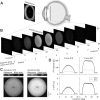Imaging Lenticular Autofluorescence in Older Subjects
- PMID: 28973367
- PMCID: PMC5627676
- DOI: 10.1167/iovs.17-22540
Imaging Lenticular Autofluorescence in Older Subjects
Abstract
Purpose: To evaluate whether a practical method of imaging lenticular autofluorescence (AF) can provide an individualized measure correlated with age-related lens yellowing in older subjects undergoing tests involving shorter wavelength lights.
Methods: Lenticular AF was imaged with 488-nm excitation using a confocal scanning laser ophthalmoscope (cSLO) routinely used for retinal AF imaging. There were 75 older subjects (ages 47-87) at two sites; a small cohort of younger subjects served as controls. At one site, the cSLO was equipped with an internal reference to allow quantitative AF measurements; at the other site, reduced-illuminance AF imaging (RAFI) was used. In a subset of subjects, lens density index was independently estimated from dark-adapted spectral sensitivities performed psychophysically.
Results: Lenticular AF intensity was significantly higher in the older eyes than the younger cohort when measured with the internal reference (59.2 ± 15.4 vs. 134.4 ± 31.7 gray levels; P < 0.05) as well as when recorded with RAFI without the internal reference (10.9 ± 1.5 vs. 26.1 ± 5.7 gray levels; P < 0.05). Lenticular AF was positively correlated with age; however, there could also be large differences between individuals of similar age. Lenticular AF intensity correlated well with lens density indices estimated from psychophysical measures.
Conclusions: Lenticular AF measured with a retinal cSLO can provide a practical and individualized measure of lens yellowing, and may be a good candidate to distinguish between preretinal and retinal deficits involving short-wavelength lights in older eyes.
Figures




References
-
- Owsley C, Jackson GR, Cideciyan AV,et al. . Psychophysical evidence for rod vulnerability in age-related macular degeneration. Invest Ophthalmol Vis Sci. 2000; 41: 267– 273. - PubMed
-
- Holz FG, Steinberg JS, Gobel A, Fleckenstein M, Schmitz-Valckenberg S. . Fundus autofluorescence imaging in dry AMD: 2014 Jules Gonin lecture of the Retina Research Foundation. Graefes Arch Clin Exp Ophthalmol. 2015; 253: 7– 16. - PubMed
-
- Fraser RG, Tan R, Ayton LN, Caruso E, Guymer RH, Luu CD. . Assessment of retinotopic rod photoreceptor function using a dark-adapted chromatic perimeter in intermediate age-related macular degeneration. Invest Ophthalmol Vis Sci. 2016; 57: 5436– 5442. - PubMed
-
- Gliem M, Muller PL, Finger RP, McGuinness MB, Holz FG, Charbel Issa P. . Quantitative fundus autofluorescence in early and intermediate age-related macular degeneration. JAMA Ophthalmol. 2016; 134: 817– 824. - PubMed
Publication types
MeSH terms
Substances
Grants and funding
LinkOut - more resources
Full Text Sources
Other Literature Sources
Medical

